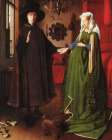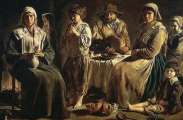| INDEX | 1300-1599 | 1600s | 1700s | 1800s | 1900s | CROSS-ERA | ETHNO | |
| MISCELLANY | CONTACT | SEARCH | |
Fashion plates are probably the most trustworthy resources as their focus is clothing and nothing else. They tend to exaggerate certain beauty ideals such as small waists, just as fashion magazines do today, but do not use artistic license where clothing is concerned. The first known fashion plates appeared at the Paris court at the end of the 17th century (unless you also count the costume books of the 16th century), reporting e.g. "What the Marquise de XY wore at the reception at the Palais Royal", much like the VIP columns in newspapers today. As the circulation was very small, only few of them survive in specialised collections.
 At
the end of the 18th century, actual fashion magazines appear where anonymous
models present fashion in hand-coloured plates. Now the styles are not necessarily
the invention of highly placed individuals anymore, but more and more often
the work of designers. The circulation includes the rich outside court but is
still small - surviving fashion plates are only found in museums or libraries.
At
the end of the 18th century, actual fashion magazines appear where anonymous
models present fashion in hand-coloured plates. Now the styles are not necessarily
the invention of highly placed individuals anymore, but more and more often
the work of designers. The circulation includes the rich outside court but is
still small - surviving fashion plates are only found in museums or libraries.
Around the mid 19th century, the class that can afford to follow
fashion expands due to the rise of the bourgeoisie. Fashion
magazines become more widespread and are found in any household
wealthy enough that the lady doesn't have to work. Magazines
of the time can still be found at affordable prices in antique
shops.
For earlier periods, however, we have to look at paintings and sculpture. But as fashion has rarely been the focus of the artist, we have to be careful not to take everything presented at face value. Each style period and each artist had priorities of their own and subjected reality to the principles of their aesthetic and composition, and to the purpose of the painting. No painting was ever as realistic as a photograph would be. Always remember that colours, shapes, distribution of shapes, postures, distortion etc may have been edited in order to get across a certain message. It helps to know about the painter, the subject(s), ideally about the circumstances under which the painting in question was created, and not the least about the socio-economic background.
 The
first instance of artistic license that comes to mind is flattery: Paintings,
espacially portraits, were usually painted to order of the subject or a relative
and therefore often flattered by making the nose straighter, the skin paler
etc than in reality. The same is true for fashion plates and even for modern-day
fashion shows where models are selected for their compliance with a certain
body aesthetic. But even if we thought that reality was truthfully depicted,
this is the least of the traps for the re-enactor as we can not make our waists
smaller or our legs longer than they are. If a fabric looks shinier or more
diaphanous than it really was, the selection available in shops usually prevents
us from re-creating the idealised image rather than reality.
The
first instance of artistic license that comes to mind is flattery: Paintings,
espacially portraits, were usually painted to order of the subject or a relative
and therefore often flattered by making the nose straighter, the skin paler
etc than in reality. The same is true for fashion plates and even for modern-day
fashion shows where models are selected for their compliance with a certain
body aesthetic. But even if we thought that reality was truthfully depicted,
this is the least of the traps for the re-enactor as we can not make our waists
smaller or our legs longer than they are. If a fabric looks shinier or more
diaphanous than it really was, the selection available in shops usually prevents
us from re-creating the idealised image rather than reality.
What is more dangerous are deviations from reality due to the aesthetic
of the period as they are not readily identified as unrealistic. In oder
to use contemporary art as a source of costume information beyond a very superficial
analysis of the general style, it is therefore necessary to be acquainted with
the general aesthetic of the period, if not the individual painter. Each period
presented on this site is therefore prefixed with a page about the era. There
is no guarantee that the images presented on this site all truthfully depict
reality - it is up to you how far you want to trust them. In the following paragraphs
I am going to  outline
some things that should be taken into account indepentent of the era in question.
outline
some things that should be taken into account indepentent of the era in question.
Some eras use a higher degree of stylisation and idealisation than others. The Renaissance, for example, still retained a certain degree of medieval formalism. The fall of fabric folds, the straightness of fabric over a bodice, the posture and even the shape of the body may be due to a lack of mastery of realism as well as to the aesthetic of the period. Example: Women's large bellies as seen in the Arnolfini marriage are said to be due to a pregnancy aesthetic following the drastic decline in population after a plague epidemic. Of course that doesn't mean that ladies didn't attempt to look like that - but don't assume that all the big-bellied ladies are pregnant, their clothing maternity wear.
 Some
eras use light and colour to evoke certain effects of mood and depth.
The colours of fabric may therefore not be accurate. Take into consideration
that the artist may have used the colours they used in order to get the contrast
of complimentary colours (e.g. the red and green in the Arnolfini marriage),
to make a reddish-clad person appear closer to the foreground than a blueish-clad
one, or to evoke a mood of celebration or gloom. Remember that the lack of colour
in the clothes of the lower classes may be due to not only the fact that that
they couldn't afford dyes that effected vivid colours, but also to the artist's
wish to emphasise the squalidness of poverty.
Some
eras use light and colour to evoke certain effects of mood and depth.
The colours of fabric may therefore not be accurate. Take into consideration
that the artist may have used the colours they used in order to get the contrast
of complimentary colours (e.g. the red and green in the Arnolfini marriage),
to make a reddish-clad person appear closer to the foreground than a blueish-clad
one, or to evoke a mood of celebration or gloom. Remember that the lack of colour
in the clothes of the lower classes may be due to not only the fact that that
they couldn't afford dyes that effected vivid colours, but also to the artist's
wish to emphasise the squalidness of poverty.
Also, when examining colours, don't forget the limitations of the technique and reproduction: The quality of the pigments and the varnish, the age of the painting, the amount of exposition to direct light and other parameters effect discoloration and darkening. Oil gives sharper outlines than pastel, fluid paint (oil, gouache) can be mixed while firm paint (pastel, chalk) can not etc. If you look at a print in a book rather than the original, the reproduction technique and paper play a huge role. Images on the web have typically been scanned and possibly edited. The scanner, the editor's screen, your web browser, and your screen all have different views of what the proper colour is.
To sum it all up: As soon as you have a handful or two of contemporary paintings by different artists that depict the same style of dress, you can begin to make assumptions about the general style of the period. But the more you go into detail, the more you have to question your source.
Content, layout and images of this page
and any sub-page of the domains marquise.de, contouche.de, lumieres.de, manteau.de and costumebase.org are copyright (c) 1997-2022 by Alexa Bender. All rights reserved. See Copyright Page. GDPO
This work is licensed under a Creative Commons License.